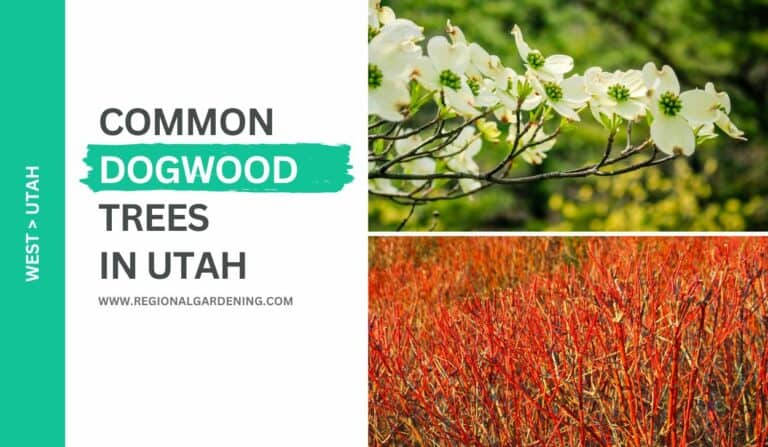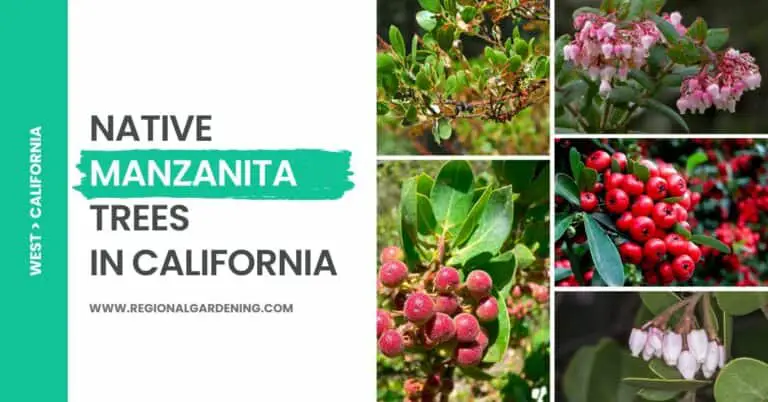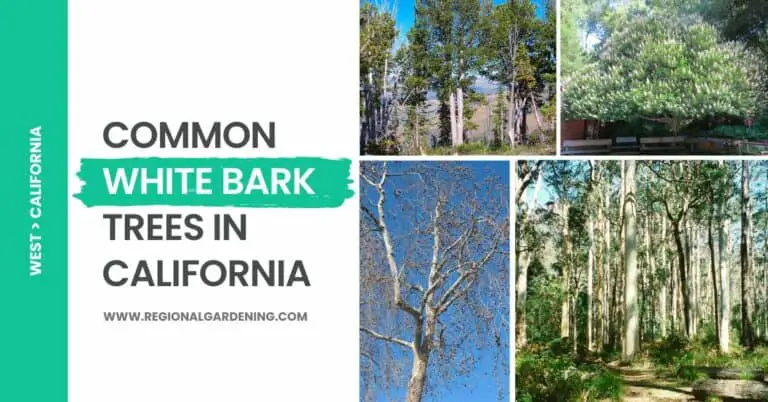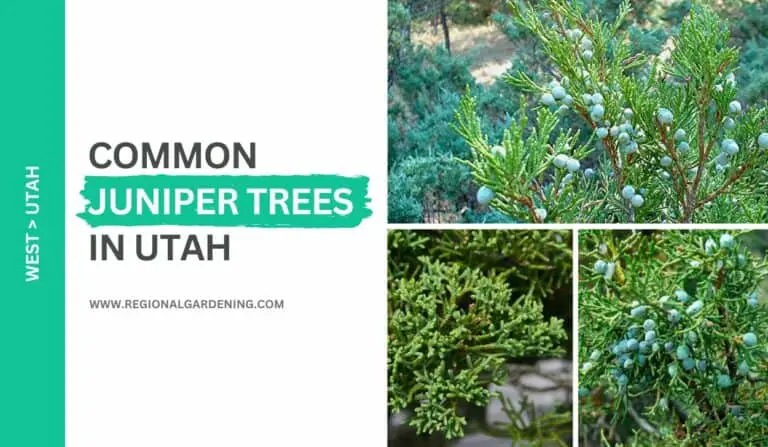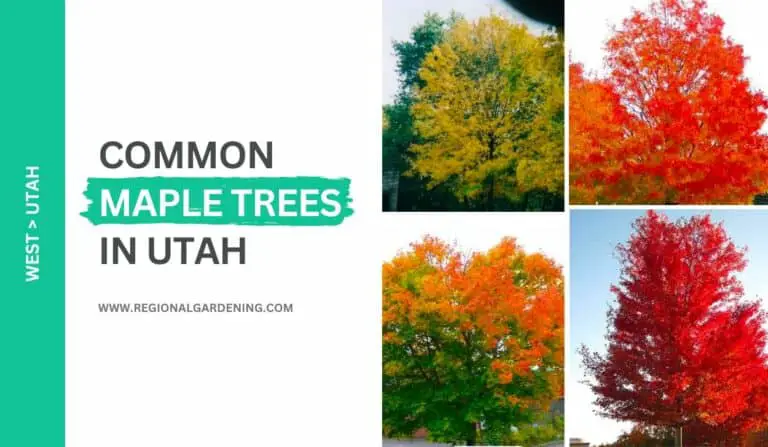16 Common Pine Trees In Utah (Photos & Identification)

Pine trees are one of the most common coniferous trees found throughout the world, and Utah’s breathtaking landscapes boast a diverse collection of pine trees, with a total of 16 common species found throughout the state. Six of these are native to the state, highlighting its distinct ecological heritage.
The genus encompasses approximately 95 pine species, with 36 found across the United States and Canada. Characterized by needle bundles, varying from 2 to 5 needles per bundle, pines feature male catkin-like pollen cones, that shed pollen in spring before falling off. Female flowers mature into woody seed-bearing cones with winged or unwinged seeds over two seasons.
Some varieties, such as the pinyon or nut pines, bear large, edible seeds. Notably intolerant of shade, pines exhibit remarkable adaptability, thriving in a wide range of soil types and environmental conditions.
This article delves into the fascinating world of native and non-native common pine trees in Utah, celebrating their ecological significance and role in shaping the landscape.
1. Limber Pine
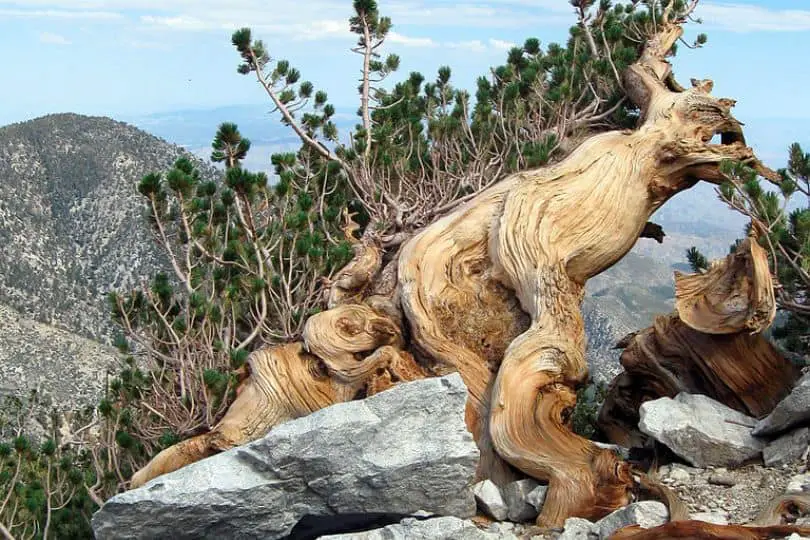
- Common Name: Limber Pine
- Scientific Name: Pinus flexilis
- Mature Height: Up to 60 feet
- Native/Non-Native: Native to higher elevations in Utah and the interior West
- Flowers/Cones: Woody cones, 3″ to 8″ long, with large wingless seeds
- Uses: Seldom used in landscapes, but it has a nice dark green color and is very tough; should be more often used; don’t over-water.
Limber Pine is one of the most commonly found pine trees in Utah. It is a tree that can reach heights of 60 feet and is native to higher elevations in Utah and the western United States.
Limber Pine needles are hard and dark green, and they are organized in groups of five. These needles will remain on the tree for around 5 to 6 years.
Limber Pine twigs are thick and very flexible, and they range in color from silver-white to gray. The buds are pointy and range in length from 1/3″ to 1/2″. The Limber Pine’s fruit is a woody cone that is short-stalked and light brown. The cones are covered in big, wingless seeds and feature thick, non-pointed scales.
Limber Pine has white to gray bark that is thin and smooth. This tree’s wood is light and delicate, and it’s not particularly important.
Limber Pine is a long-lived and slow-growing tree that is commonly found in arid and severe conditions. It is also particularly sensitive to shade. Limber Pine is not usually utilized in landscaping, but it should be because it has a wonderful dark green color and is quite sturdy. It is, nevertheless, critical not to overwater the tree.
2. Bristlecone Pine
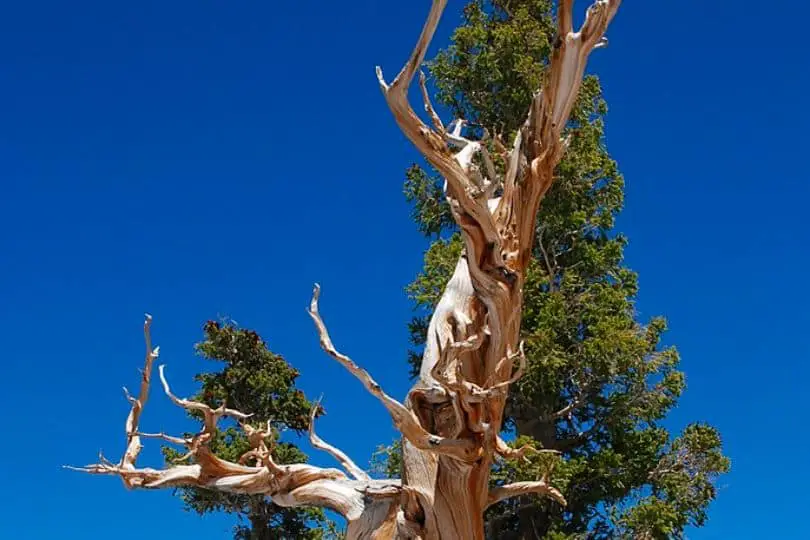
- Common Name: Bristlecone Pine
- Scientific Name: Pinus aristata
- Mature Height: Varies
- Native/Non-Native: Native
- Flowers/Cones: Woody cones with long bristles
- Uses: Landscaping
The Bristlecone Pine, commonly known as Pinus aristata, is an interesting and unusual tree. It can be found in mountainous places throughout the interior West, including Utah. This tree has certain unique qualities that distinguish it from other trees.
Long, dark green needles grow in groups of five on the Bristlecone Pine. These needles are twisted and tough, and they can stay on the tree for 10 to 17 years. Close inspection will reveal that the needles are delicately coated in white flecks of dried resin.
This tree’s twigs and buds are also remarkable. The twigs begin orange-brown and eventually turn black. Brown scales cover the buds, which are about a third of an inch long.
The Bristlecone Pine’s fruit is a woody cone. These cones are brown and have a short stalk. The cone’s scales are thick and covered in long bristles. Small seeds with wings can be found inside the cone, which is smaller than the seeds of the Limber Pine.
The Bristlecone Pine’s bark varies as it ages. It is slender, silky, and gray-white on young stems. On elder stems, however, it becomes wrinkled and red-brown.
Despite its unique characteristics, the Bristlecone Pine is rarely employed in landscaping. It should, however, be used more frequently because it has a wonderful dark green color and an unusual, occasionally distorted structure.
This tree grows slowly and requires little to no more water once established. It thrives in harsh, arid settings. So, if you want to grow a variety that is very low maintenance, then bristlecone pine is the best among all pine trees in Utah.
3. Colorado Pine
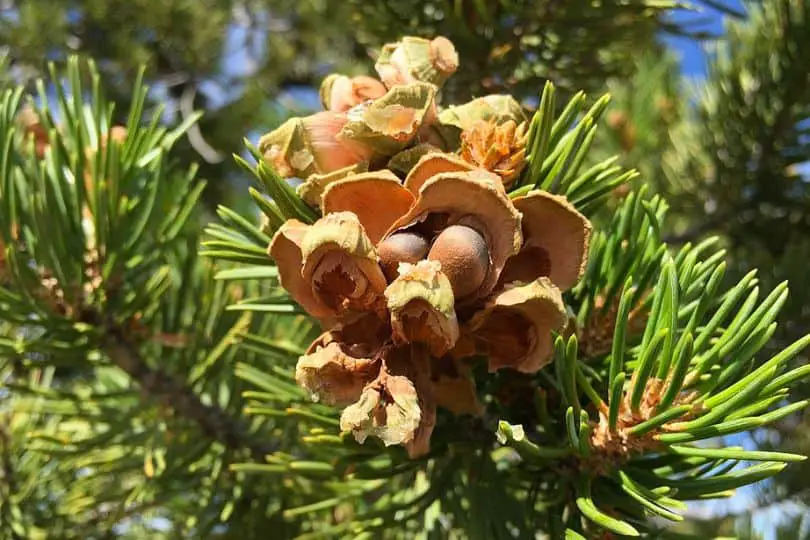
- Common Name: Colorado Pinyon
- Scientific Name: Pinus edulis
- Mature Height: Up to 50 feet
- Native/Non-Native: Native to southern, central, and eastern Utah and the southwestern United States
- Flowers/Cones: Woody cones without stalks, oval to round, reddish-brown, with few scales and large, wingless seeds
- Uses: Seeds are edible and have been an important food source for southwestern Native American tribes. The wood is mainly used as firewood and sometimes for fence posts.
Colorado Pinyon (Pinus edulis) is one of the types of native pine trees in Utah endemic to southern, central, and eastern Utah, as well as the southwestern United States. It can mature to a height of up to 50 feet. This tree’s needle-like leaves grow in groups of two and measure around 1 to 2 inches long. They’re somewhat stiff and yellow-green. The twigs are thick and orange to brown in hue, with little oval brown buds.
The Colorado Pinyon’s blossoms are not particularly showy. They instead grow woody cones with no stems that are 1 to 2.5 inches long and oval to spherical. These cones are reddish-brown in hue with a few scales that are not topped with a prickle. The seeds inside the cones are enormous and wingless, averaging around half an inch in length. They have a thin shell and are edible, making them an important food source for several Native American tribes in the Southwest.
The Colorado Pinyon is not highly prized for its wood. Because of its hardness, it is mostly used for firewood and occasionally for fence posts. This tree is commonly found in dry areas, often near juniper plants. It is not shade tolerant and can be found in some housing projects’ landscapes, albeit it may not grow owing to over-watering and root damage. It’s also worth noting that in these conditions, pinyon trees might be a fire hazard.
4. Single Leaf Pine
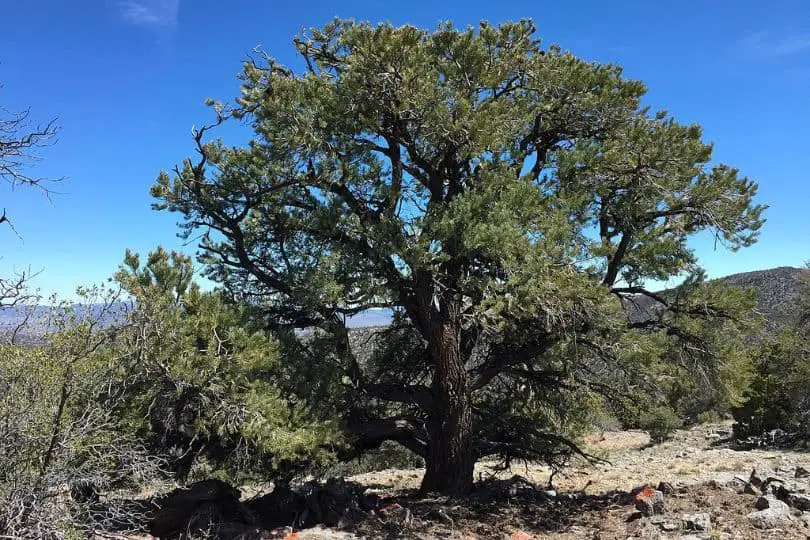
- Common Name: Singleleaf Pinyon
- Scientific Name: Pinus monophylla
- Mature Height: Up to 50 feet
- Native/Non-Native: Native
- Flowers/Cones: Male cones are yellow and female cones are green.
- Uses: Edible seeds, landscaping
Singleleaf Pinyon, scientifically known as Pinus monophylla, is a different type of pine tree distinguished by its distinctive characteristics. Unlike other pine trees, the needles of the Singleleaf Pinyon grow individually on the branches rather than in groups. As a result, it is the only pine tree with needles that grow independently on the twig. This tree’s needles are evergreen and can remain on the tree for 4-12 years.
The Singleleaf Pinyon is located in a few isolated sites and is native to mid-elevations. It is mostly found in northern Utah, Nevada, and areas of central and southern California, as well as Baja California. This tree loves dry areas and is considered to be shade-intolerant.
The seeds of the Singleleaf Pinyon tree, like those of its near sibling, the Pinyon tree, are edible. They, like Pinyon seeds, can be picked and consumed. The Singleleaf Pinyon is rarely utilized in landscaping, despite its tasty seeds. It is frequently encountered in natural surroundings or native locations.
If you are thinking about planting a Singleleaf Pinyon tree in your garden, keep in mind that it is hardy in Zones 5-9. This indicates that it may survive in climates ranging from moderate to mild.
5. Ponderosa Pine
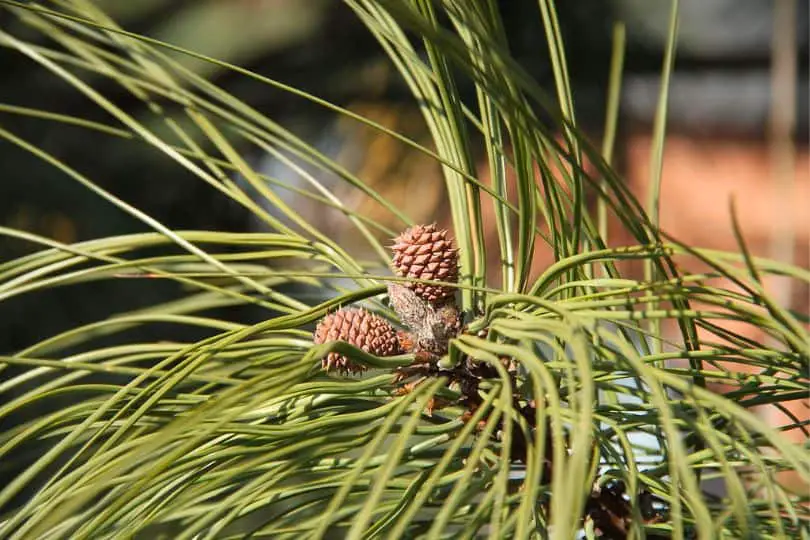
- Common Name: Ponderosa Pine
- Scientific Name: Pinus ponderosa
- Mature Height: Can grow up to 180 feet tall
- Native/Non-Native: Native to mountainous areas in southern two-thirds of Utah and throughout the West
- Flowers/Cones: Woody cones that are 3″ to 6″ long, reddish-brown in color, and each scale armed with a short, sharp spine
- Uses: Used for lumber, millwork, and railroad ties
One of the tallest pine trees in Utah, the Ponderosa Pine, scientifically known as Pinus ponderosa, can grow up to a massive 180 feet in height. This natural tree can be found in hilly places throughout the West, including the southern two-thirds of Utah.
Ponderosa Pine needles constitute the leaves, which are frequently seen in clusters of two or three. These needles are yellowish-green in hue and range in length from 3 to 10 inches. The needles of the Ponderosa Pine are less pointed and more twisted than those of the Austrian pine. They persist on the tree for around 3 to 6 years, remaining evergreen throughout the seasons.
The twigs of the tree are thick and orange-brown in hue. They have a turpentine-like odor when crushed. Ponderosa Pine buds are about half an inch long and covered in resin droplets. They are cinnamon-brown in hue, which adds to the tree’s natural charm.
When it comes to reproduction, this tree produces small, woody cones with little to no stalk. These cones are reddish-brown in hue and can reach a length of 3 to 6 inches. Each cone scale has a short, pointed spine.
The bark of the Ponderosa Pine is unusual. Younger trees have dark brown to black bark, and elder trees have wide, thick plates that range in hue from orange to cinnamon-red. Deep furrows separate these plates. The inner bark of the tree smells like vanilla.
The wood of the Ponderosa Pine is one of the reasons it is so valuable. The sapwood ranges from white to yellow, while the heartwood ranges from yellow to light brown. The wood’s growth rings are striking, giving it a distinct appearance. This wood is widely utilized in the construction industry as lumber, millwork, and railroad ties.
Although the Ponderosa Pine is occasionally planted in landscapes for its beauty, it is crucial to note that a similar-looking tree known as the Austrian pine is more regularly found in nurseries.
The Ponderosa Pine grows slowly, yet it is well-known for its ability to withstand fires due to its thick bark. It is also drought tolerant, which means it can survive in arid environments. It does not, however, tolerate shade well.
6. Lodgepole Pine
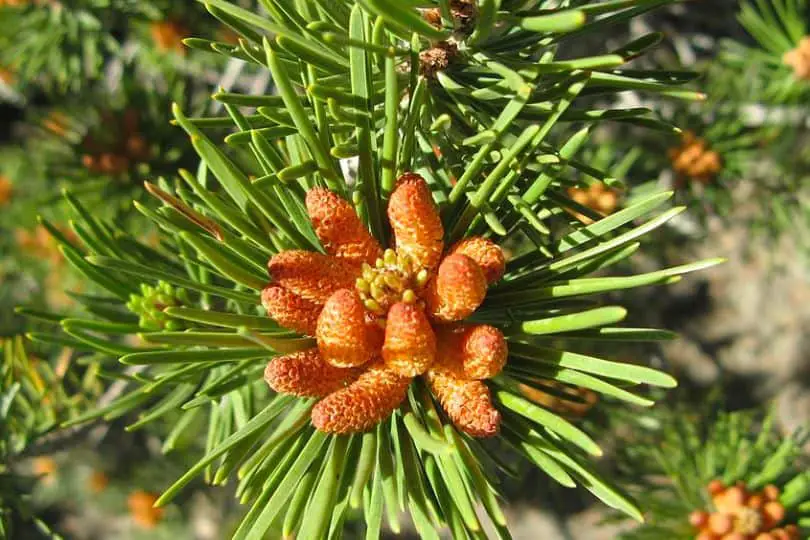
- Common Name: Lodgepole Pine
- Scientific Name: Pinus contorta or P. contorta var. latifolia
- Mature Height: Can grow up to 100 feet tall
- Native/Non-Native: Native to higher elevations in northern Utah and throughout the West and western Canada
- Flowers/Cones: Produces woody cones that are oval-shaped and brown, turning gray as they age. Each cone scale has a prickly tip. Some cones remain tightly closed for many years, which is called serotinous.
- Uses: The wood of the lodgepole pine tree is used for making lumber, posts, poles, and railroad ties.
The lodgepole pine is a type of evergreen tree with needles that grow in pairs. These needles are yellow-green in color, robust, and range in length from 1 to 3 inches. They live on the tree for 4 to 6 years. The tree’s twigs are thick and fluctuate in color from orange-brown to black as they age. Lodgepole pine buds are about 1/4 inch long and covered in resin, giving them a dark brown look.
Even on older trees, the bark of the lodgepole pine is orange-brown to gray and thin. It has a scaly texture. The wood of the tree is somewhat important, with a light brown heartwood. The wood is often used to create lumber, posts, poles, and railroad ties due to its toughness.
This tree is native to higher elevations in northern Utah, as well as the western United States and Canada. It grows slowly and is frequently seen in dense stands produced by wildfires. Although the lodgepole pine is drought tolerant, it does not tolerate shade well. As a result, except in circumstances where a more natural and less manicured appearance is sought, it is rarely planted in landscaped areas. It can be grown in zones 2 through 6.
7. Austrian Pine
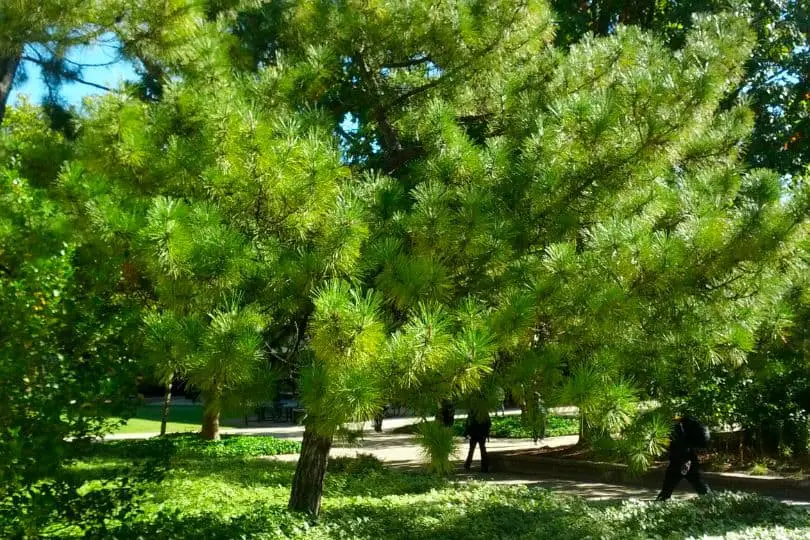
- Common Name: Austrian Pine
- Scientific Name: Pinus nigra
- Mature Height: 50 to 80 feet
- Native/Non-Native: Non-Native
- Flowers/Cones: Woody cone, reddish-brown, about 2 to 3 inches long, non-pointed scales
- Uses: Widely planted in landscapes, good for individual or mass planting
The Austrian Pine is one of the most commonly available pine trees in Utah nurseries despite being a nonnative species. It is a medium-sized tree that can grow to be 50 to 80 feet tall when fully mature. It is not native to the United States, but it has thrived in the Utah climate. It has distinguishing characteristics that set it apart from other trees.
This tree has long, narrow, stiff needles that grow in pairs. The needles are yellow-green to blue-green and last roughly 3 to 4 years on the tree. The tree’s twigs are orange-brown and silky, and the buds are silvery and striped, measuring 1/2 to 3/4 inch long.
The Austrian Pine has reddish-brown woody cones that are 2 to 3 inches long. The scales on the cones are not pointed. The bark of the tree is tough and platy, originally dark brown but turning gray as it ages. The heartwood of the Austrian Pine is a characteristic red-brown hue and is slightly greasy and sticky.
This tree can be found in many locations throughout Utah and the Western United States. It is well-known for its toughness and lengthy needles. Despite its non-native status, it has remained disease and insect-free in Utah. Other areas, however, have had problems with Zimmerman pine moth, Diplodia tip blight, and Dothistroma needle blight.
The Austrian Pine can withstand a wide range of environments but is sensitive to shade. It is widely used in both individual and large plantings. It is most typically found in zones 4 to 7, making it ideal for a wide range of climates.
8. Scots Pine
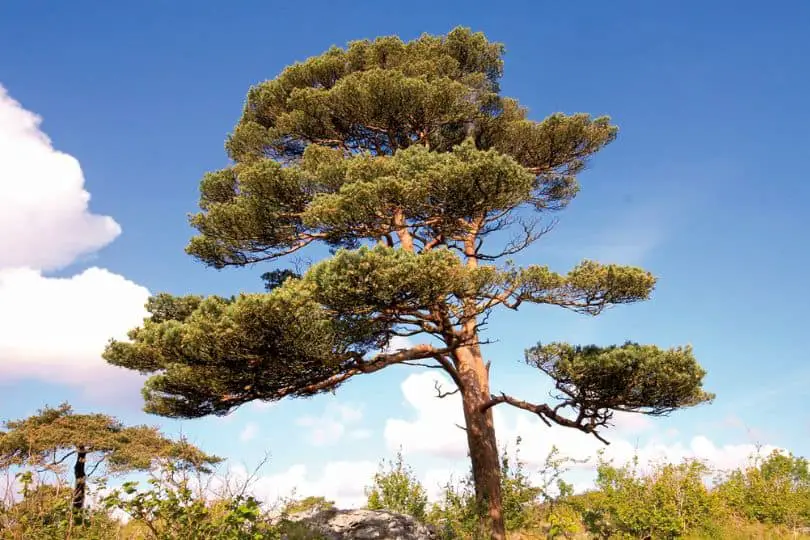
- Common Name: Scots Pine
- Scientific Name: Pinus sylvestris
- Mature Height: 50-70 feet
- Native/Non-Native: Native to Europe; widely planted in Utah
- Flowers/Cones: Woody cone, 1-1/2″ to 2″ long, reddish-brown
- Uses: Popular for Christmas tree production; widely planted in landscapes
When fully grown, the Scots Pine can reach heights of 50 to 70 feet. It is native to Europe, but due to its favorable properties, it has been widely planted in Utah.
Scots Pine leaves are needle-like and appear in clusters of two. They have a blue-green tint that can turn yellow-green in the winter. These needles can last up to three years on the tree.
Scots Pine twigs are medium in thickness and have a dull gray-yellow tint. The buds are pointy and can range in length from 1/4″ to 1/2″. They feature red-brown scales and fringed scales. The tree produces woody cones that measure approximately 1-1/2″ to 2″ in length. These cones have reddish-brown scales with high pyramid-shaped tops.
The bark of the Scots Pine is bright orange on the top limbs and trunk. In terms of wood usage, little information about this tree is accessible in the US wood products business.
The Scots Pine is a popular landscape plant in Utah and the western United States. It is a popular material for making Christmas trees. The tree is relatively disease- and insect-free, though it may exhibit needle yellowing (chlorosis) when planted in alkaline soils or overwatered. The Scots Pine is shade intolerant, which means it grows best in bright sunlight.
Overall, the Scots Pine is one of the lovely pine trees in Utah that add color and character to any landscape. It is a hardy species that can withstand a variety of conditions, making it excellent for planting in zones 2-8.
9. Eastern White Pine
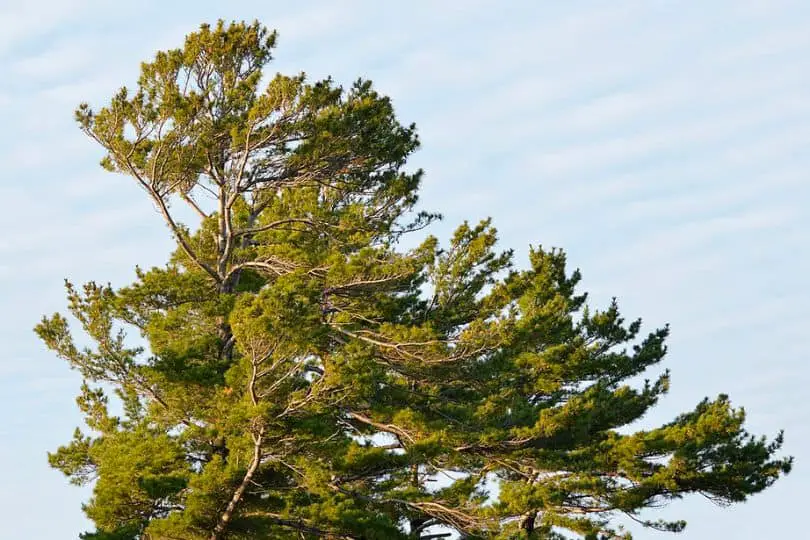
- Common Name: Eastern White Pine
- Scientific Name: Pinus strobus
- Mature Height: Can reach heights of up to 80-100 feet
- Native/Non-Native: Native to the eastern United States
- Flowers/Cones: Produces woody cones that are about 4 to 8 inches long; narrow with thin, non-pointed scales
- Uses: Wood from the Eastern White Pine has been historically important; it is used for lumber, fine millwork, and even for sailing-ship masts
Pinus strobus, or Eastern White Pine, is a tall and magnificent tree native to the eastern United States. It can reach heights of 80-100 feet, making it one of the tallest pine trees in Utah.
The needle-like leaves of the Eastern White Pine grow in groups of five and are roughly 3 to 5 inches long. They are dark blue-green in hue and turn light green in the winter in regions like Utah. These needles are thin and flexible, allowing them to resist extreme weather conditions. They last roughly 2 to 3 years before falling from the tree.
Eastern White Pine twigs are orange-brown and can be smooth or somewhat hairy. This tree’s buds are covered in thin, red,d or orange-brown scales, giving them a distinct appearance.
The Eastern White Pine produces woody cones that range in length from 4 to 8 inches. These cones have stalked, slender structures with thin, non-pointed scales. They play an essential role in the reproductive cycle of the tree.
On young stems, the bark of the Eastern White Pine is thin, smooth, and gray. The bark of the tree deteriorates into rectangular plates as it matures. This tree’s wood also features distinct growth rings, making it useful for a variety of purposes.
While the Eastern White Pine is native to the eastern United States, it can also be found in Utah. However, it may struggle to survive in the region’s alkaline soil, resulting in chlorosis. Regardless, the tree is still widely accessible in nurseries.
10. Himalayan Pine
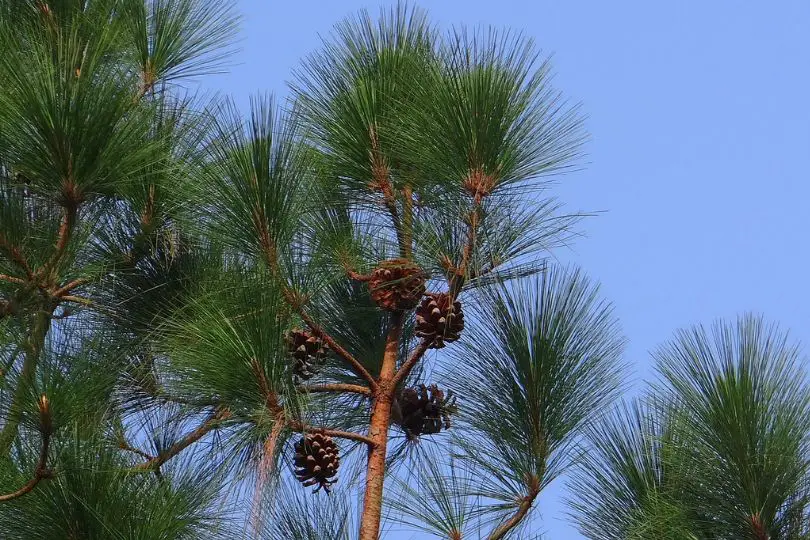
- Common Name: Himalayan Pine, Bhutan Pine
- Scientific Name: Pinus wallichiana
- Mature Height: Potentially a large tree
- Native/Non-Native: Native to Afghanistan, Nepal, and China; occasionally planted in Utah
- Flowers/Cones: Woody cones, light-brown when ripe
- Uses: Ornamental
The Himalayan Pine, commonly known as the Bhutan Pine, is a magnificent tree of the Pinus wallichiana genus. This evergreen tree can grow extremely large, perhaps reaching a towering height when mature. Its leaves, sometimes known as needles, are distinctive and easily identified. When they mature, they become slender, drooping, and feathery, measuring 5″ to 8″ in length. The needles are grayish-green in hue and last about 3 to 4 years before falling off the tree.
The fruit of the Himalayan Pine is one of its most intriguing characteristics. The tree produces woody cones that are about 8″ to 10″ long and 2″ wide, turning a light-brown hue when ripe. These huge, interesting cones contribute to the tree’s overall appeal.
The Himalayan Pine is native to Afghanistan, Nepal, and China, but it has been planted in Utah on occasion. While it can adapt to a variety of environments, it thrives best in areas with average moisture and protection from dry summer winds and late-day winter sun. It is not shade tolerant and prefers to bask in sunlight.
The long needles and big cones of the Himalayan Pine make it a remarkable addition to any garden or park. However, it is crucial to know that the Himalayan Pine may not be cold-hardy and may struggle in exceptionally cold areas.
In conclusion, the Himalayan Pine, also known as the Bhutan Pine, is a remarkable tree that can grow quite tall. Its slender, drooping needles and large, woody cones make it a visually appealing addition to any landscape. Despite being native to Afghanistan, Nepal, and China, it is quite common in Utah, thus making it on the list of common pine trees in Utah.
11. Swiss Mountain Pine

- Common Name: Mugo Pine, Swiss Mountain Pine
- Scientific Name: Pinus mugo
- Mature Height: Varies, can get quite large or stay small if using dwarf cultivars.
- Native/Non-Native: Native to mountains of central and southern Europe.
- Flowers/Cones: Woody cones, ovoid in shape, gray-black when mature.
- Uses: Commonly used in mass plantings, tolerant of various conditions.
The Mugo Pine, sometimes known as the Swiss Mountain Pine, is a tree found in the mountains of central and southern Europe. It is a shrubby tree that can grow fairly large if not given adequate room, however dwarf c, cultivars are available for smaller spaces.
The Mugo Pine has stiff needles that are 1.5 to 3 inches long, are a medium green color, and stay on the tree for five years or more. The tree also produces cones that are woody and ovoid, are 1 to 2 inches long, and turn gray-black when fully mature.
The bark of the Mugo Pine is scaly and gray-brown, unlike the bark of certain other varieties of pine trees, which is orange on the top trunk.
This tree is exceptionally hardy and can withstand a wide range of conditions, including freezing temperatures, alkaline soil, and moderate drought; nevertheless, it is not shade tolerant and loves to be in full sun.
Mugo Pine is a highly popular shrub in Utah that is typically planted in mass plantings; nevertheless, it is necessary to choose the proper type for the size of the planting area; if the area is small, true dwarf cultivars are advised.
12. Japanese White Pine
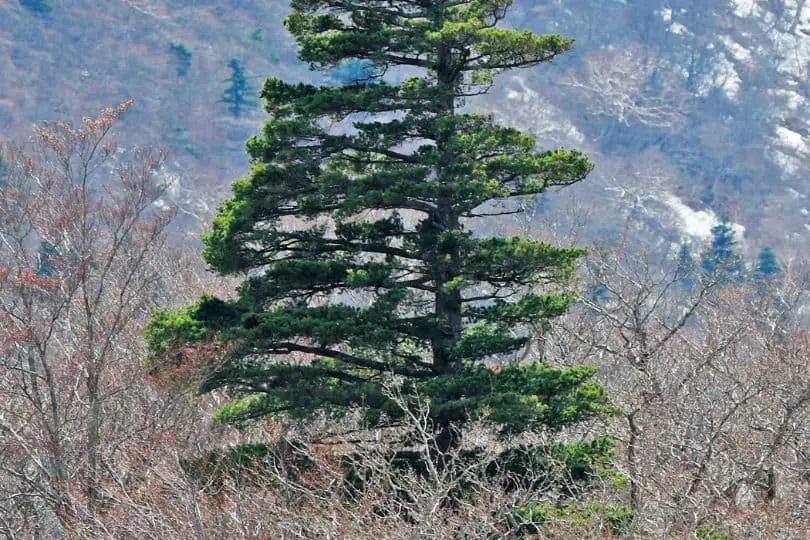
- Common Name: Japanese White Pine
- Scientific Name: Pinus parviflora
- Mature Height: 25′ to 50′
- Native/Non-Native: Native to Japan
- Flowers/Cones: Woody cones, reddish-brown, 1-1/2″ to 4″ long
- Uses: Good tree for landscaping, fine-textured foliage
The Japanese White Pine, scientifically known as Pinus parviflora, is a beautiful evergreen tree native to Japan. It is a relatively short tree that can reach a height of 25 to 50 feet when fully grown. The leaves of the Japanese White Pine are needle-like and come in bundles of five. They are stiff, twisted, and tufted near the branch ends.
The Japanese White Pine produces reddish-brown woody cones that are quite short and may or may not have a stalk, measuring anywhere from 1-1/2″ to 4″ in length and remaining on the tree for 6 to 7 years.
The Japanese White Pine demands moderate rainfall and is salt resistant, although it does not perform well in shady places. Because of its fine-textured leaf, this tree is particularly well-suited for landscape reasons.
13. Lacebark Pine
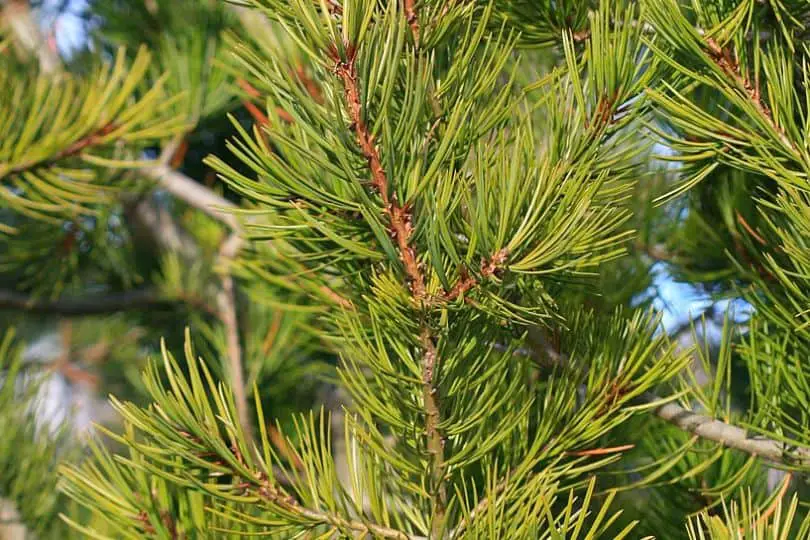
- Common Name: Lacebark Pine
- Scientific Name: Pinus bungeana
- Mature Height: Can grow to be quite tall
- Native/Non-Native: Native to China
- Flowers/Cones: Produces woody cones with curved, triangular spines on the tips of the scales
- Uses: Can be grown as a specimen tree for its showy bark
The Lacebark Pine has one of the showiest barks among pine trees in Utah. It is a distinctive and attractive tree native to China that may grow to be fairly tall. Its leaves are dark green, stiff, and evergreen, meaning they stay on the tree for 3 to 4 years.
The lacy patches that peel off in varied hues, including green, white, and brown, are one of the most distinguishing elements of the Lacebark Pine’s bark, which is sometimes compared to the bark of a London planetree.
This tree can withstand a wide range of environments, including neighboring concrete; it is also cold and alkaline-soil tolerant, but it does not grow well in shady regions. Its crown shape and foliage are similar to Scotch pine, and it is frequently used as a specimen tree to exhibit its attractive bark.
If you live in zones 4-8, you can plant a Lacebark Pine in your garden or yard. It is a very desirable tree that should be planted more frequently because its unique bark and overall appearance make it a standout addition to any outdoor space.
14. Japanese Black Pine
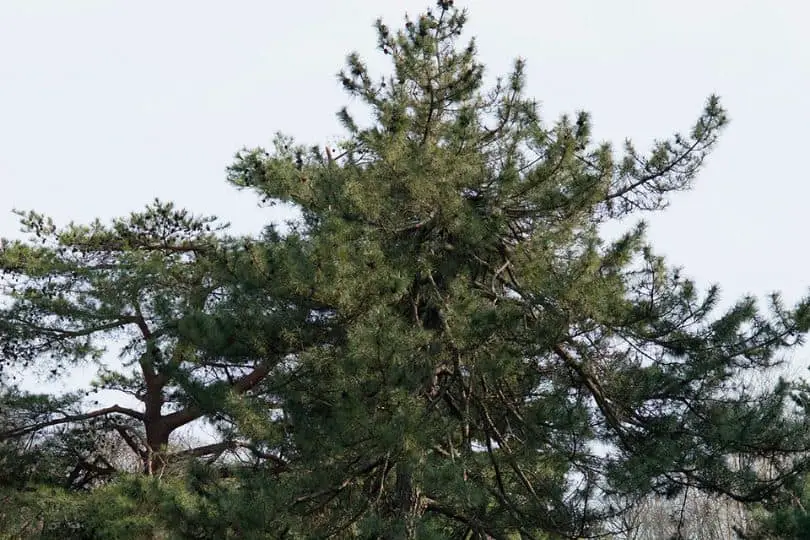
- Common Name: Japanese Black Pine
- Scientific Name: Pinus thunbergiana
- Mature Height: Can grow up to 50-60 feet tall
- Native/Non-Native: Native to Japan
- Flowers/Cones: The tree produces woody cones that are 1-1/2″ to 2-1/2″ long and brown.
The Japanese Black Pine, also known as Pinus thunbergia, is a species of tree native to Japan that may grow up to 50-60 feet tall and has stiff, evergreen needles that are 2″ to 4″ long. The needles are firm and stay on the tree for 3 to 5 years.
This tree produces woody cones that are 1-1/2″ to 2-1/2″ long and brown, with rounded or very small prickles at the tips.
The Japanese Black Pine is a strong tree that can endure salt and drought, but it does not grow well in shaded locations. It has an uneven shape that adds to its distinctive appearance.
This tree is well-suited to Utah’s environment and grows well in Zones 5-9. It has lovely dark green foliage, which adds a bit of variation to the options for landscape pine trees.
15. Japanese Red Pine
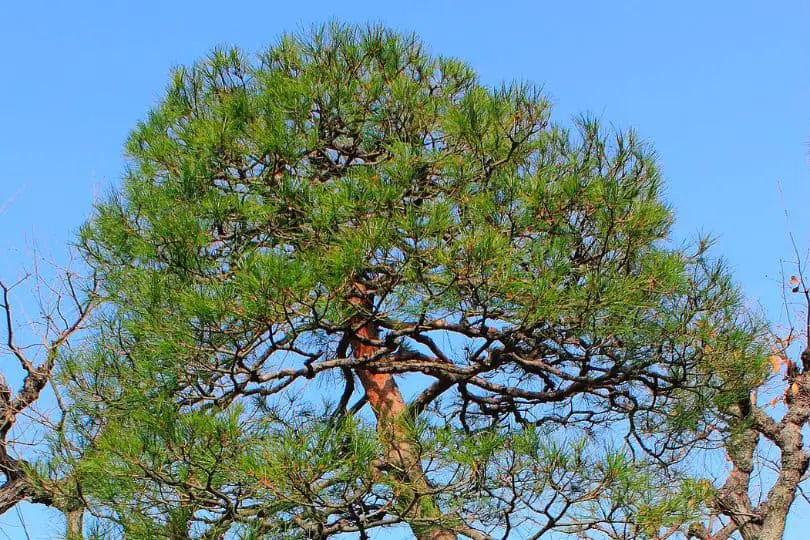
- Common Name: Japanese Red Pine
- Scientific Name: Pinus densiflora
- Mature Height: Potentially large tree, though slow-growing
- Native/Non-Native: Native to Japan, Korea, and China
- Flowers/Cones: Woody cones, dull yellow
- Uses: Nice large tree, attractive bark
The Japanese Red Pine, also known as Pinus densiflora, is a tree that can grow to be extremely tall but does so slowly. It is endemic to Japan, Korea, and China, and it has some interesting characteristics.
The Japanese Red Pine’s leaves are needles that develop in bundles of two. These needles are slender, twisted, and bright to dark green, and they stay on the tree for roughly three years, ensuring that the tree always looks green and lush.
The Japanese Red Pine also develops woody cones that are about 1-1/2″ to 2″ long and have a dull yellow color. These cones remain on the tree for 2 to 3 years and are a mechanism for the tree to reproduce and make additional trees.
The bark of the Japanese Red Pine is unique in that it is orange-red when young and peels off in scales. As the tree grows older, the bark turns gray near the base, giving the tree an intriguing and appealing appearance.
The Japanese Red Pine is a very hardy tree that can survive in very cold weather and grows well in zones 3-7. It takes medium levels of water and can thrive in a variety of soil types, although it does not like a shadow and prefers full sun.
16. Aleppo Pine
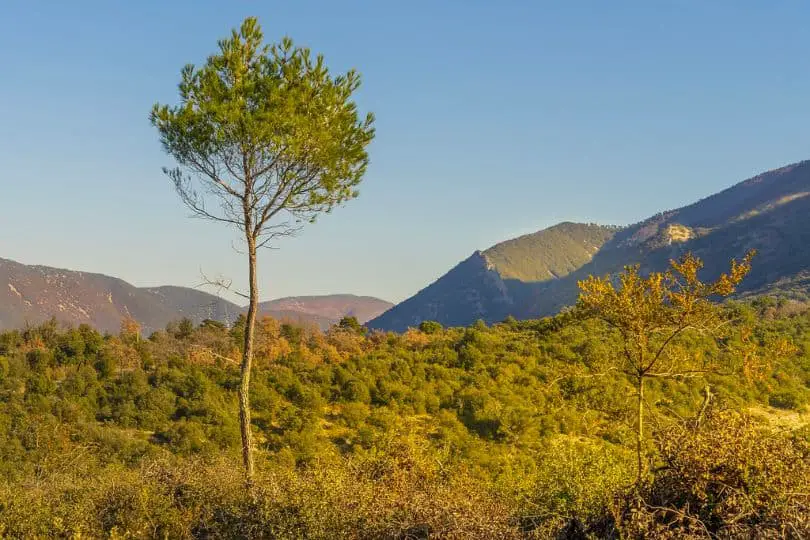
- Common Name: Aleppo Pine
- Scientific Name: Pinus halepensis
- Mature Height: Can grow up to 60 feet tall
- Native/Non-Native: Native to southern Europe, northern Africa, and parts of Asia
- Flowers/Cones: Cones are red to yellow-color.
- Uses: Used in warm desert climates where a pine tree is desired; not suitable for areas with regular hard frosts.
The Aleppo Pine, which is native to southern Europe, northern Africa, and portions of Asia, is well-suited for hot and arid desert regions, but it is not cold-resistant and cannot withstand regular harsh frosts.
Its tall and colorful presence can lend shade and beauty to warm desert environments where a pine tree is sought. However, it is vital to avoid planting the Aleppo Pine in locations with continuously cold winters, as it may not survive.
The Aleppo Pine requires very little water to survive because of its tolerance to hot and dry regions, and it is also not tolerant of shade and it is best cultivated in locations with plenty of sunlight.
Similar Articles
- Common Oak Trees in Utah
- Common Magnolia Trees In Utah
- Common Ash Trees In Utah
- Common Spruce Trees In Utah
- Common Elm Trees In Utah
- Common Birch Trees In Utah
- Common Poplar Trees In Utah
- Common Maple Trees In Utah
- Common Dogwood Trees In Utah
- Common Nut Trees In Utah
- Common Cedar Trees In Utah
- Common Willow Trees In Utah
- Common Alder Trees In Utah
- Common Cypress Trees In Utah
- Common Beech Trees In Utah
- Common Juniper Trees In Utah
- Common Fir Trees In Utah
- Common Plum & Cherry Trees In Utah
- Common Palm Trees In Utah
Common Pine Trees In Utah – Sources
The Regional Gardening team makes sure that the information in our articles is accurate by only using sources that are known to be trustworthy. Some of these sources are peer-reviewed journals from government agencies, well-known universities, and scientific research organizations.
- Trees & Shrubs In Yard And Garden, Utah State University Extension
- Native & Non-Native Tree Identification, Utah State University Forestry Extension.
- Native Plants, Utah Native Plant Society.
- A Guide To The Trees Of Utah & Intermountain West, Book By Michael Kuhns, Utah State University Press.


